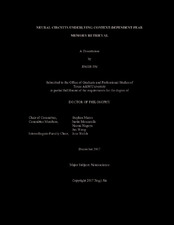| dc.description.abstract | Exposure therapy for stress- and anxiety-related disorders is very effective, but fear
return after treatment is not uncommon. During extinction, repeated exposure to a
conditioned stimulus (CS) gradually decreases the probability and magnitude of the
conditioned fear response (CR). However, extinction does not eliminate the fear
memory; rather, it generates a new extinction memory that competes with the fear
memory for control of behavior. Importantly, the extinction memory is highly contextdependent
insofar as it is only expressed in the extinction context. That is, if the CS is
encountered outside of the extinction context, the conditioned fear response returns or
‘‘renews’’. The renewal of extinguished fear is a considerable challenge for maintaining
long-lasting fear suppression after exposure therapy. The hippocampus, the medial
prefrontal cortex (mPFC) and the amygdala are thought to play essential roles for
context-dependent memory retrieval after extinction, but the circuit mechanism is not
clear. To explore the neural circuits underlying contextual regulation of fear memory
retrieval, we first used functional tracing approach to examine the activity of prelimbic
prefrontal cortex (PL)- and basal amygdala (BA)-projecting neurons in the ventral
hippocampus (vHPC) during extinction retrieval and fear renewal. We then used circuitspecific
chemogenetic approach to examine the role of infralimbic prefrontal cortex (IL)-
projecting vHPC neurons in contextual retrieval. Finally, we used pharmacological and
chemogenetic approaches to test the role of the nucleus reuniens (RE) in contextdependent
fear memory retrieval. The results showed that vHPC inputs to both the PL and BA are activated during fear renewal, with PL- and BA-dual projecting neurons
showing the greatest level of activation. Moreover, we showed that IL-projecting vHPC
neurons are required for fear renewal by inducing feedforward inhibition within the IL.
Lastly, we demonstrated that the RE is required for extinction retrieval, and the
prefrontal modulation on the RE activity is essential in this process. Together, these
results provided circuit mechanisms underlying context-dependent fear memory
retrieval. | en |


